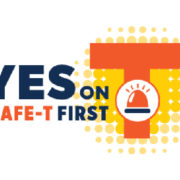
SAN Jose Mayor Sam Liccardo, community advocates and residents are encouraging voters to vote yes on Measure T which is included in the coming November 6 ballot. This was the gist of a media briefing at Rock Springs Park in San Jose on Thursday, October 24 which was one of the neighborhoods that were inundated by water during torrential rains almost two years ago.
The measure addresses the city’s aging infrastructure and emergency preparedness and response to natural disasters.
According to information provided by proponents of Measure T, it will make San Jose safer by:
• Upgrading 911 communications facilities to improve emergency response
• Rebuilding police training facilities and repairing crumbling fire stations
• Upgrading the emergency operations center
• Replacing deteriorating, earthquake-vulnerable bridges
• Restoring safe locations for emergency food and shelter for displaced families
• Fixing potholes and repaving roads to prevent accidents
• Reducing flooding by rebuilding parts of the 70-year-old sewer system and preserving natural open space that absorbs water during heavy rains.
Measure T is supported by a wide coalition, including Mayor Sam Liccardo, US Congressman Ro Khanna, Assemblymember Evan Low, Vice Mayor Magdalena Carrasco, Fire Chief Robert Saplen, former Mayor Chuck Reed, all members of the San Jose City Council, former Chamber of Commerce CEO Jim Cunneen, the Silicon Valley Leadership Group, La Raza Roundtable, Sierra Club, League of Women Voters, Santa Clara County Democratic Party and Save The Bay Action Fund.
In his remarks, Mayor Liccardo said, “I want to be sure that our residents never again pay again for our lack of investment in their safety. With Measure T, we are moving forward with a $650 million investment in keeping our community safe.”
“We are here because we know these investments will critically help our community be safer. It will also help us maintain the critical infrastructure we have neglected for decades – everything from our streets and roads, to our fire stations. With regard to flood protection, there are particular elements of this measure that will be uniquely relevant. We have a strong sewer system which is, in parts of our city, 70 to 80 years old that need to be rebuilt. We have fire stations that are teetering, one of which may fall into a creek if a sufficient earthquake were to prompt it to move. We need firefighters to be ready to help our community and not struggle with the poor condition of their own facilities,” Mayor Liccardo continued.
“And what I think is a monumental investment is that we are committing $50 million to buy land in the Coyote Valley. We know that Coyote Creek flooded that caused so much devastation in our community… We know that it was the spillover of water from Anderson Dam that caused inundation in our neighborhoods, and we need to critically find a way to divert that water and store it before it gets into our neighborhoods and dense areas of our city. Coyote Valley offers an opportunity for us to retain water that is spilling over from Anderson Dam, inundating Coyote Creek and keeping it in a preserved area, away from development, away from people,” he added.
The Mayor also said other benefits of the measure include protection of wildlife corridors, and protection of underground aquifers from pollution/pollutants.
Mayor Liccardo finished his remarks by saying that the measure invests in the city’s safety and future, and “allows our children to make good decisions with our resources rather than making those decisions for them.”
The briefing gave Mayor Liccardo an opportunity to break down some of the areas where the $650 million from Measure T will be allocated: $300 million will be dedicated to restoring the city’s worst roads; up to $50 million will be allocated for Coyote Valley; tens of millions of dollars will be allocated to repair seismically-vulnerable bridges; some of the money will be allocated for the rebuilding of fire stations (Station 8 and Station 23) and building of new fire stations for the city’s rapidly-growing population, as well as the replacement and upgrading of the 9-1-1 communications system and the city’s storm sewer system.
Funding for Measure T, which is a bond measure, will come from bond dollars issued as a result of a property tax assessment, which Mayor Liccardo put at 11 cents for every thousand dollar in valuation. The cost, according to the Mayor, will be around $60 to $65 per house, as the average assessed value for a San Jose homeowner is about $530,000.
Mayor Liccardo also made it clear that the money generated by Measure T will be capitally-restricted, “meaning it can only be used to build things or buy land upon which you may build things or protect from development. It cannot be used to increase salaries or pensions or anything else for staff. This is about construction projects that we build and land that we purchase, and that’s it. Under state law, you can’t use capitally-restricted money to pay my salary. So, that is important for voters to know that we are going to see projects out of this investment.”
Other speakers at the briefing included Minh Ngoc Do, whose close friends were pushed out of their home for a long period due to flooding in the Rock Springs Park area; city councilmember Tam Nguyen; and Alice Kaufman of the Committee for Green Foothills.
[More information about Measure T can be found at SaferSan Jose.org.]







